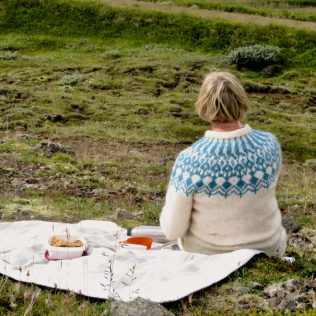5 weird+5 must-try Icelandic local dishes you should (at least give it a) try in Iceland
One of the best ways to experience the culture of a new country is by trying the local cuisine. Iceland people are very proud of their heritage and Icelandic food, with unique cooking and fermentation methods that have been used for hundreds of years. Due to its climate and isolation from the rest of Europe, Icelandic cuisine was crafted with survival in mind.
Icelanders had to make do with what ingredients were available to them, and the cold temperatures throughout most of the year made growing crops more difficult. For this reason, most of the traditional Icelandic food is meat-based. Restaurants do offer vegan and vegetarian options to eat in Iceland, and there is lots of produce available at local shops, but when it comes to tasting traditional Icelandic food, most of it is made using meat, fish or dairy.
If you’re travelling to Iceland, then we highly recommend trying out some Icelandic food. Although some of it might seem unusual, it’s a great way to experience local culture. Here are the top Icelandic dishes you need to try when visiting Iceland.

Table of content
Quick Q&A about food in Iceland
- How much is food in Iceland? Is food expensive in Iceland?
- Do Icelandic people eat whales?
- What kind of food do they eat in Iceland?
- What is the most famous food in Iceland?
5 weird+5 must-try Icelandic local dishes
- Weird Icelandic food: Hakarl – Fermented Shark
- Weird Icelandic food: Hrútspungar – Sour Ram’s Testicles
- Weird Icelandic food: Svið – Sheep’s Head
- Weird Icelandic food: Slatur – Icelandic Liver Pudding
- Weird Icelandic food: Thorlaksmessa – Fermented Skate
- Must-try Icelandic food: Pylsur – Hot Dog
- Must-try Icelandic food: Skyr – Yogurt
- Must-try Icelandic food: Rúgbrauð – Rye bread
- Must-try Icelandic food: Icelandic lamb dishes
- Must-try Icelandic food: Fish and seafood

Quick Q&A about food in Iceland
When most people think of Iceland, they think of Iceland black sand beaches, blue glacier ice caves and hot springs. And while travellers may not visit Iceland specifically for the local food, if you want a true local experience, then you should sample some of the popular foods in Iceland. Here are some of the most common questions about Icelandic food.
How much is food in Iceland? Is food expensive in Iceland?
Compared to food in the United States and other European countries, yes, the food is expensive. The main reason for the high prices is Iceland’s isolation and climate, meaning a lot of food needs to be imported from other countries. That said, locally produced food like Icelandic milk, skyr (Icelandic yogurt), eggs and Icelandic lamb are relatively cheaper than imported foods. Here are some common foods and how much you can expect to spend on them:
- Bread: 400 ISK/$2.81 USD
- Rice: 390 ISK/$2.74 USD per kilogram
- Pasta: 198 ISK/$1.39 USD
- Milk: 200 ISK/$1.40 USD per liter
- Eggs: 650 ISK/$4.56
- Cheese: 1,700 ISK/$11.93 USD per kilogram
- Bananas: 310 ISK/$2.17 USD per kilogram
- Tomatoes: 530 ISK/$3.72 USD per kilogram
- Sausage: 2,700 ISK/$18.94 USD per kilogram
- Chicken: 2,050 ISK/$14.38 USD per kilogram
▷ Related reading: Iceland currency guide; Iceland travel information

Do Icelandic people eat whales?
There has always been some controversy over the eating of whales in Iceland. And while it’s definitely not an everyday food, it is a part of Icelandic cuisine. Icelanders started hunting whales as far back as the 12th century.
As you can imagine, one whale could feed the local population for a long time, but they stopped commercial whaling in 1986 after a worldwide ban was adopted by the International Whaling Commission. The ban still allowed for the hunting of minke whales and fin whales, but the whaling of fin whales has stopped over the last few years.
Now, the minke whale is the only whale meat that you will find in Iceland, and it’s primarily consumed by tourists as a novelty, not by locals. Whale meat was traditionally consumed for survival, and as there is now access to an abundance of food options in Iceland, there is no reason to hunt and eat whale anymore.
We encourage tourists to avoid eating minke whales when in Iceland to help decrease the demand and instead take a whale-watching tour to see these gentle giants in their natural habitat. Only by decreasing demand can we hope to see the whaling industry stopped for good.
- Related link: Iceland nature and animals
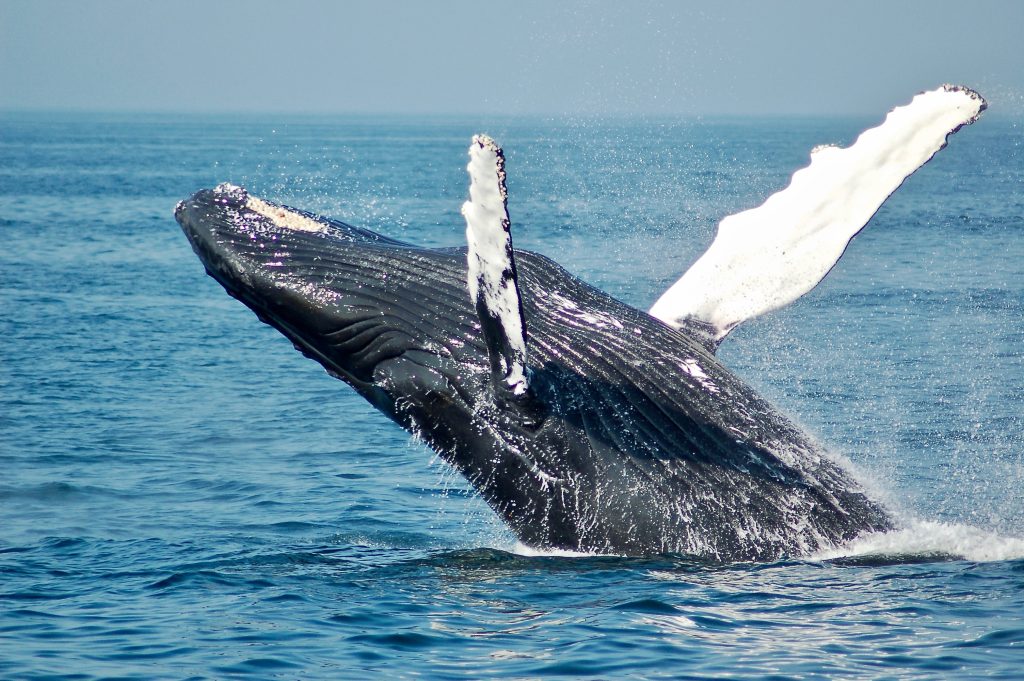
What kind of food do they eat in Iceland?
The staples of Icelandic food have been the same for thousands of years. In such a hostile environment, Icelanders relied on what they could fish, hunt and farm (primarily lamb). Until recent innovations in geothermal greenhouses, there wasn’t much farmable land in Iceland, so they didn’t have a lot of vegetables or fruits to work with. But even so, many Icelanders still eat the traditional staples of lamb, fish and skyr (Icelandic yogurt).
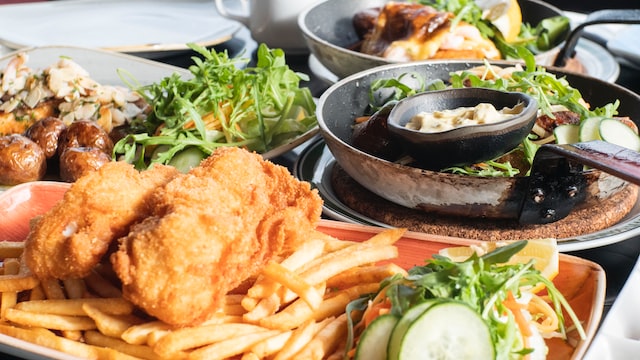
What is the most famous food in Iceland?
The food in Iceland is famous for one of two reasons, either because it’s tasty or because it’s just plain weird! There are many famous foods in Iceland, and we are going to cover five of the weirdest Icelandic foods and five that you must try!
Weird traditional Icelandic food: Hakarl – Fermented Shark
One of the weirdest Icelandic foods is Hakarl, which is fermented shark meat. While that may not sound like the strangest thing you’ve ever heard, what is weird about it is that the shark meat is actually poisonous when it’s raw because of the high ammonia content. But after fermenting for at least six weeks underground, it’s safe to eat.
After in-ground fermentation, the shark meat is hung for five months to dry. Hakarl is served in cubes, and the smell and taste may put you off instantly, but if you’re feeling adventurous, then you should give it a try. It’s often chased with a shot of Brennivin, an Icelandic spirit, to help mask the taste.
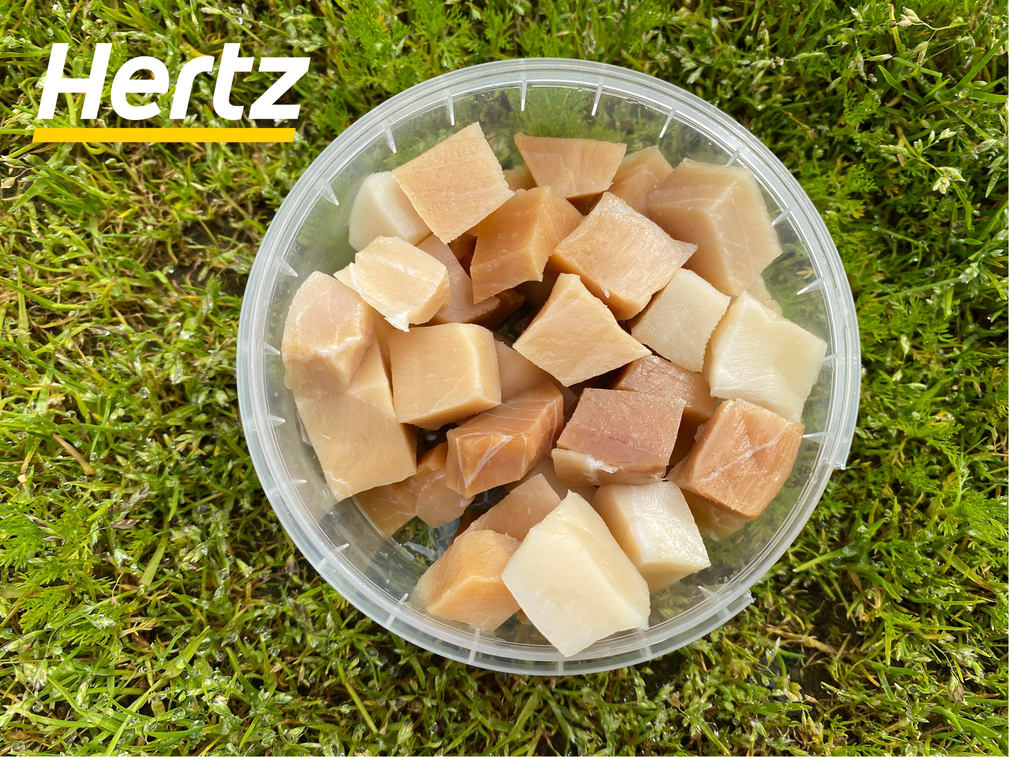
Weird traditional Icelandic food: Hrútspungar – Sour Ram’s Testicles
In order to survive, Icelanders have always maximized their resources, and that means eating every part of the animals they hunted and farmed. And we mean EVERY part.
Hrútspungar is pickled ram’s testicles, made by preserving the testicles of a ram in whey or gelatin. Hrútspungar is then served pâté style with added spices and can be spread on bread. It’s not as common as it used to be, for obvious reasons, but it’s still a delicacy in Iceland.
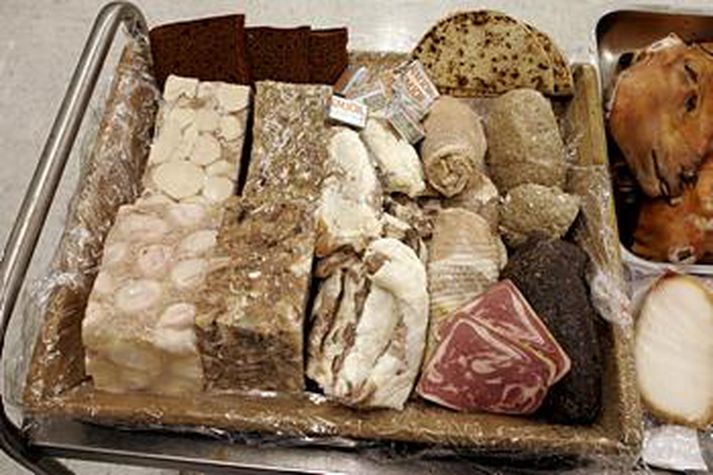
Weird traditional Icelandic food: Svið – Sheep’s Head
If you thought that Hrútspungar would be hard to eat, wait until you try Svið. Svið is the entire head of the sheep, which is typically boiled but may also be smoked or served in jelly. You can always find Svið served during Þorrablót, a traditional Icelandic festival honoring the old Norse gods, which runs from the end of January until the end of February.
In fact, this festival is the prime time of the year to sample other weird traditional Icelandic food. You’ll struggle to find Svið at typical restaurants in Iceland during other times of the year. Wondering what part to eat? Well, Icelanders eat everything, including the eyes, but they skip on the ears, which culturally has an association with theft.
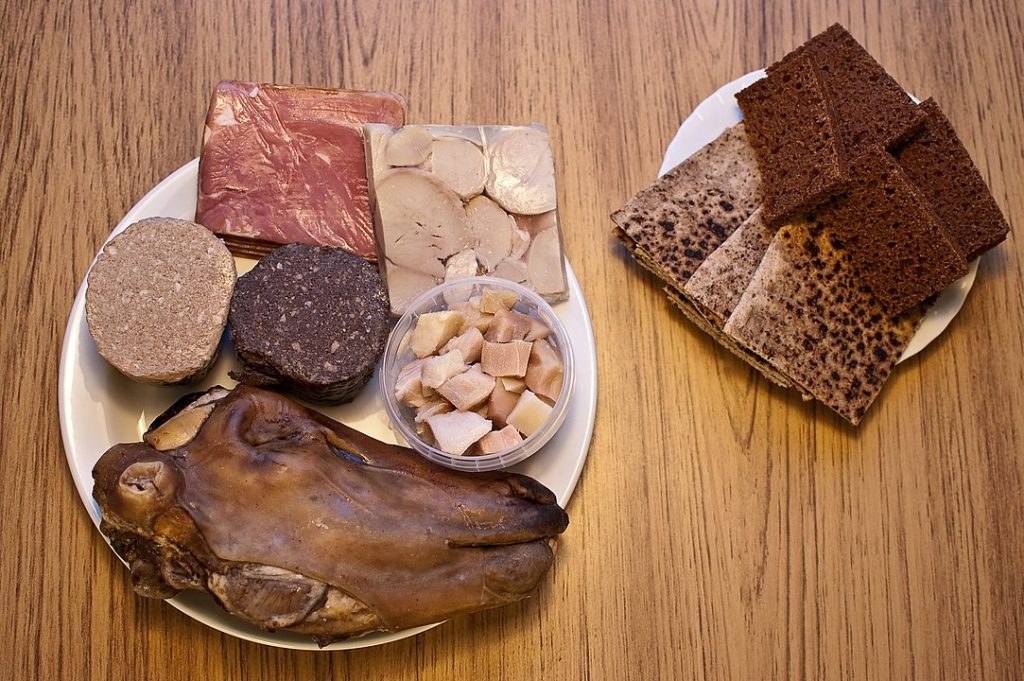
Weird traditional Icelandic dish: Slatur – Icelandic Liver Pudding
You may be noticing a trend here, and that’s that Icelanders make sure that nothing goes to waste. One of the best ways to use up extra parts of the sheep is to make it into Slatur, a liver pudding that is similar to black pudding, but it may also appear more like a sausage.
Slatur is made with sheep’s liver, kidneys and fat, along with rye, oats and some added spices. It’s easier to find this dish at restaurants in Reykjavik Iceland than some of the others on our weird list, and it will typically come with some turnip and potatoes. But the best time to find it is during the Þorrablót festival.
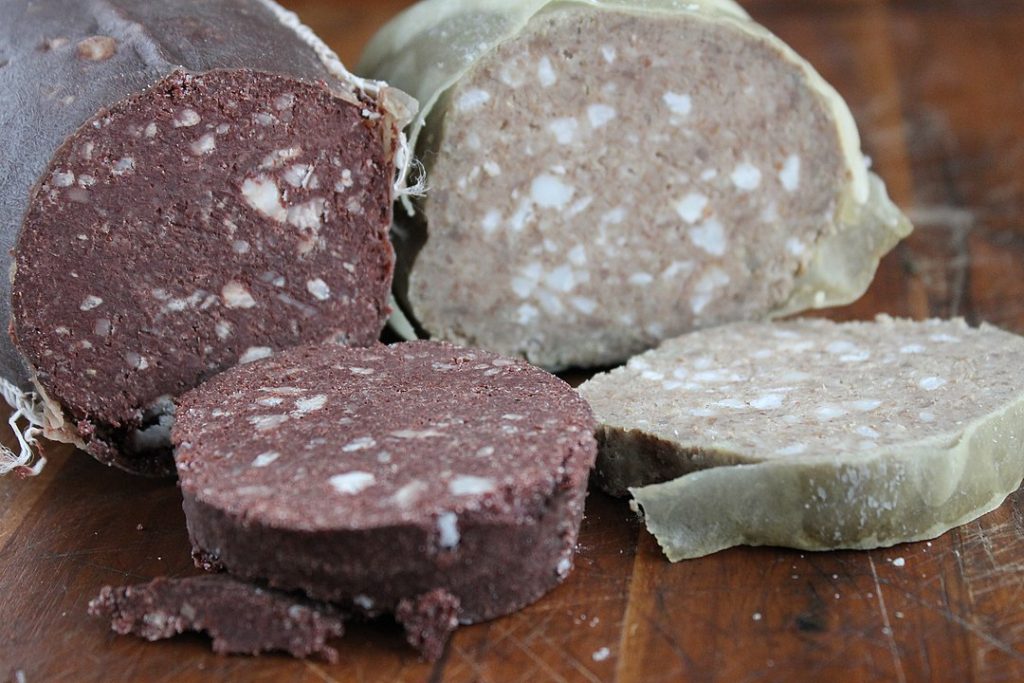
Weird Icelandic traditional dish: Thorlaksmessa – Fermented Skate
Skate is a common type of ray that is found in many parts of the world, and Icelanders would ferment is as a way to preserve it. Fermented skate has quite a strong odor of ammonia, which is why many choose to avoid it. But some say the taste is more similar to salted fish.
Thorlaksmessa is actually the name of a pre-Christmas feast honoring Saint Thorlak, a patron saint of Iceland, where the dish is served. Not only is the dish extremely pungent, but the slimy texture also makes it hard to swallow, especially for those with a weak stomach.
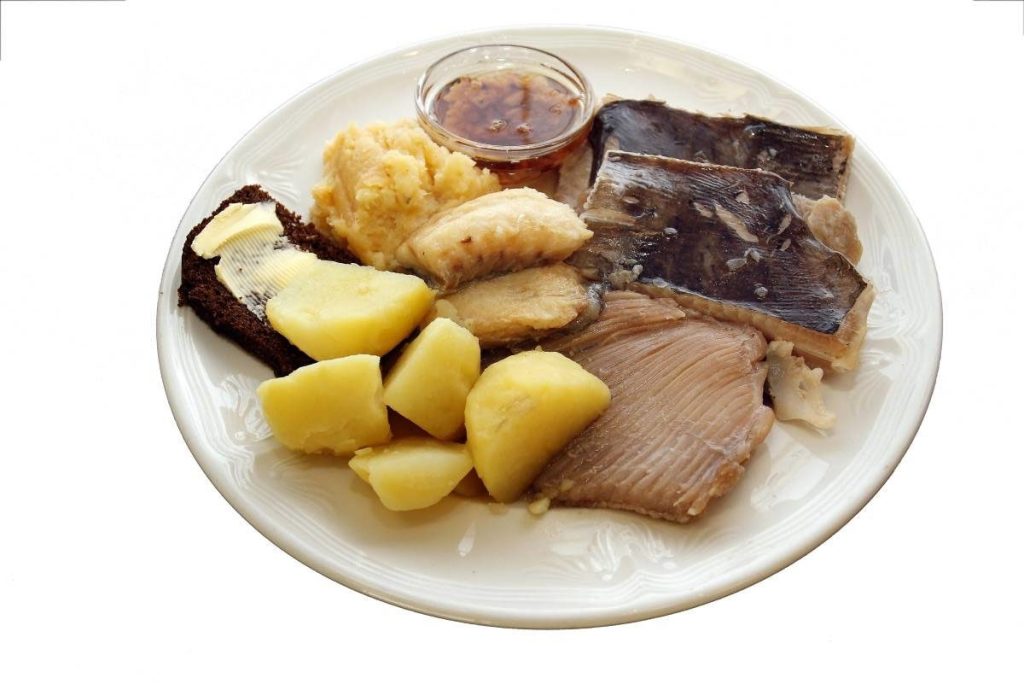
Must-try Icelandic food: Pylsur – Hot Dog
We’ve all had a hot dog before. But have you had an Icelandic hot dog? For those that were slightly put off by the weird Icelandic foods, we can promise this one will be more familiar.
Pylsur is a hot dog made from a blend of lamb, beef and pork that is very popular in Reykjavik. You have to try the iconic Bæjarins Beztu Pylsur, a stand that has been operating since 1937. The Pylsur is topped with mustard, deep-friend onions and remoulade sauce.
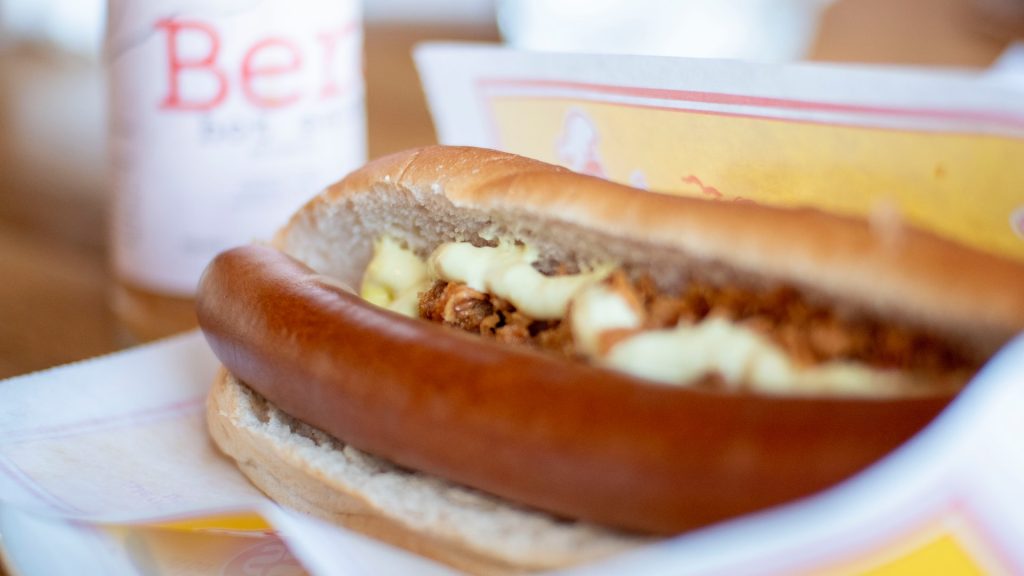
Must-try Icelandic food: Skyr – Yogurt
Skyr is a delicious, cream Icelandic soft cheese, which is more similar in consistency and taste to Greek yogurt. You’ll be hard-pressed to find an Icelander who doesn’t have some Skyr on hand to add to their smoothies, eat for breakfast and mix with berry jam. It’s made using the same process used to make yogurt, by adding live culture to pasteurized milk and allowing it to thicken.
You can find this just about anywhere in Iceland, including restaurants, grocery stores and convenience stores. If you don’t like Yogurt, going for any Icelandic dairy products (milk, cheese) would also be a good choice.
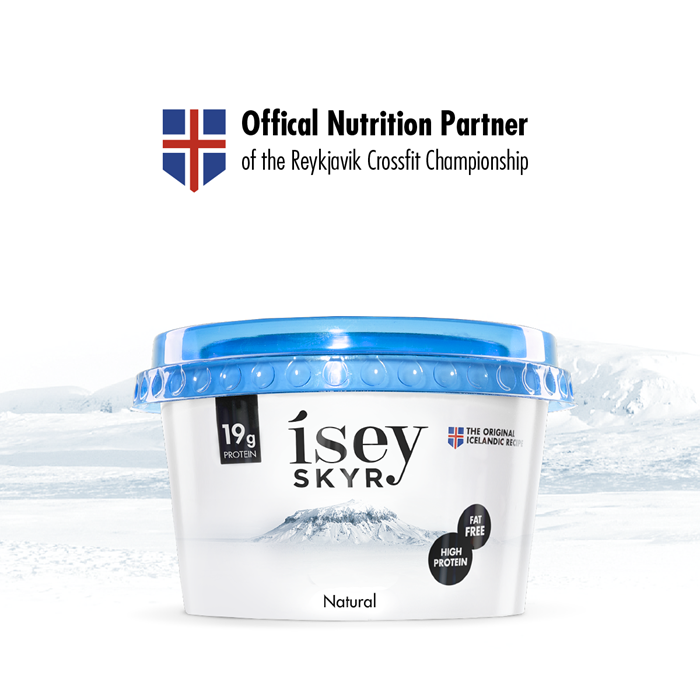
Must-try Icelandic food: Rúgbrauð – Rye bread
While rye bread may be common across most of Europe, no one does it quite like the Icelanders do. Rúgbrauð is baked in a pot that’s buried next to geothermal geysers and Iceland hot springs, where the moist heat from the geyser slowly bakes the bread.
It is famous of being the dark rye bread from a hot spring. The result is a crustless loaf of soft rye, which is almost cake-like in texture. You can top Rúgbrauð with just about anything, but it’s delicious with just some butter and salt. Try it alongside a fish stew, or top it with some local fish or smoked lamb.

Must-try Icelandic food: Icelandic lamb dishes
If you want to eat like a true Icelander, than don’t leave the country without trying a lamb dish. Lamb has been the most abundant grazing animal in Iceland for many centuries and has served as the main meat source. The sheep are free to roam, and you’ll definitely spot herds when driving around the country.
Some of the lamb dishes you need to try include Hangikjot, which is smoked lamb, and hearty lamb meat soup (KJÖTSÚPA), which is packed with root vegetables like potatoes, carrots and turnip, this dish is offered in most traditional Icelandic restaurants . The warm soup is perfect to warm you up after outdoor adventures to the blue glacier ice caves in Iceland, or Iceland volcanoes.
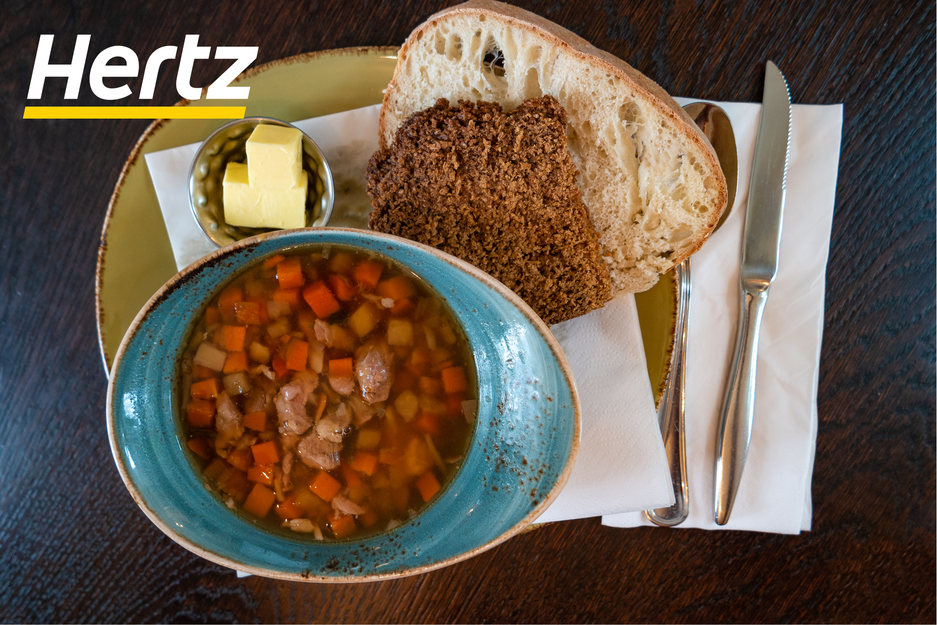
Must-try Icelandic food: Fish and seafood
Second to lamb, Icelandic fish and seafood have always been abundant in Iceland, as the entire country is surrounded by open ocean. You’ll find lots of haddock, cod, salmon and lobster readily available at many restaurants around Iceland. Traditionally, with a means of freezing or refrigerating fresh fish, fish was dried and cured to help it last.
Harðfiskur is the name, and it’s incredibly popular in Iceland to this day. Fish stew is another staple of the Icelandic diet, and many restaurants put their own twist on this dish.
Lobster is also another dish you must try when in Iceland, although it’s often smaller than you might expect. You’ll find a dish called Humar, which is just the tail of the lobster, but it can be quite expensive. Humar is used in soups, baked, grilled or even on pizza.
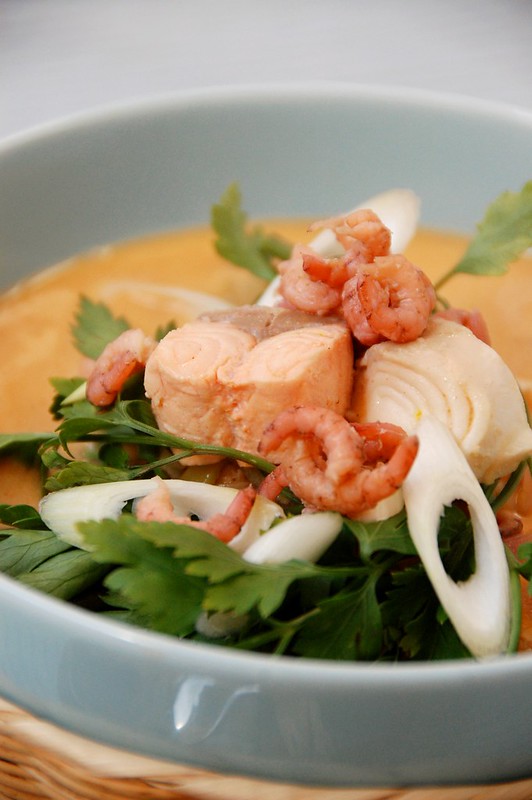
What Icelandic food should you try?
Icelandic food is a huge part of Icelandic culture. If you’re visiting Iceland, then sampling the cuisine is a great way to embrace local culture and push yourself out of your comfort zone. And if you are not a fan of any of the Icelandic food listed above, here are some alternatives for you to consider:
- Brennivin: known as “Black Death”, a Icelandic’s distinctive spirit.
- Puffin Meat: There are a few restaurants offers puffin meat dishes in Iceland, you can find them in Reykjavik and other big cities of Iceland
The best way to get around Iceland is with a rental car, which will give you the flexibility to visit Iceland attractions and the local towns that serve up the dishes on this list. Check out some of our Iceland rental car tips to help you find the perfect rental car for your group, and make sure to book online and in advance with Hertz. Get your stomach ready for some unique dining experiences that are unlike anything you will have tasted before.
